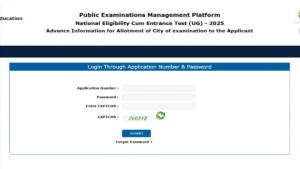
Ncert Solutions For Class 11 Biology Chapter 19 in English
Adda 247 provides NCERT Solutions for Class 11 Biology Chapter 19 which is for the students who want to go ahead in life and achieve great marks in their examinations. The NCERT Solutions for class 11 are provided by the teachers who are experts in their subjects. The solutions are set according to the rules formulated by the NCERT class 11 biology and in the language that can be understood by every student. By reading the solutions students can build up a strong base easily. The NCERT class 11 Biology solutions cover chapters 1 to 22 with the important questions and the answers in a detailed way.
Examinations can be threatening for some people, a proper learning of the concepts is the key to crack the examination. Students rely on the solutions of the NCERT provided by Adda 247. The solutions are formulated by the experts of the subjects who have tremendous knowledge in their subjects.
These NCERT Solutions of class 11 help the students to get familiarized with the textbooks. The students can access the solutions anywhere while browsing the web easily. The solutions are very precise and accurate.
NCERT Solutions for Class 11 Biology Chapter 19 – Excretory products and their elimination
The chapter provides information about Excretory products and their elimination. Excretion is the removal of nitrogenous waste products and other metabolites from the animal body which is normally associated with the process of maintenance of osmotic concentrations, i.e., osmoregulation within the body.
Both excretion and osmoregulation are important for the maintenance of homeostasis, i.e., for keeping the internal environment of the body constant that is necessary for normal life processes.
Ammonia, urea and uric acid are the major forms of nitrogenous wastes excreted by animals. These substances get accumulated in the animal body either by metabolic activities or by other means like excess ingestion.
[sso_enhancement_lead_form_manual title=”Download Full PDF of Class 11 Biology Chapter 19 ” button =”Download Now” pdf =”/jobs/wp-content/uploads/2021/06/26175024/English-chapter-19.pdf”]
Features of the NCERT Solutions for Class 11 Biology Chapter 19 – Excretory Products and Their Elimination
NCERT Solutions of class 11 have been answered based on the important information on the question.
- The columns are used wherever necessary.
- Solutions are solved point-wise and accurately answered point to point.
Important Question for Class 11 Biology Chapter 19 Excretory Products and Their Elimination
Question 1. Define Glomerular Filtration Rate (GFR)
Answer: The amount of the filtrate formed by the kidneys per minute is called glomerular filtration rate (GFR). The value of GFR in a healthy individual is approximately 125 ml/minute i.e., 180 litres per day
Question 2. Explain the autoregulatory mechanism of GFR.
Answer: The mechanism by which the kidney regulates the glomerular filtration rate is autoregulative. It is carried out by the juxtaglomerular apparatus. Juxtaglomerular apparatus is a microscopic structure located between the vascular pole of the renal corpuscle and the returning distal convoluted tubule of the same nephron.
It plays a role in regulating the renal blood flow and glomerular filtration rate. When there is a fall in the glomerular filtration rate, it activates the juxtaglomerular cells to release renin. This stimulates the glomerular blood flow, thereby bringing the GFR back to normal. Renin brings the GFR back to normal by the activation of the renin-angiotensin mechanism.
Question 3. Indicate whether the following statements are true or false:
(a) Micturition is carried out by a reflex.
(b) ADH helps in water elimination, making the urine hypotonic.
(c) Protein-free fluid is filtered from blood plasma into the Bowman’s capsule.
(d) Henle’s loop plays an important role in concentrating the urine.
(e) Glucose is actively reabsorbed in the proximal convoluted tubule.
Answer:
(a) True
(b) False
(c)True
(d) True
(e) False
Question 4. Give a brief account of the counter current mechanism.
Answer: The function of the counter-current mechanism that operates inside the kidney is to conserve the water and make the urine concentrated. The counter-current mechanism depends upon the loops of Henle, vasa recta, collecting ducts and interstitial fluid. The blood flows in the two limbs of the tube in opposite directions giving rise to the counter-currents. The proximity between the loop of Henle and vasa recta, as well as the counter-current in them, help in maintaining an in increasing osmolarity towards the inner medullary interstitial fluid i.e. 300 mOsmol/L in the cortex to 1200 mOsmol/L in the inner medulla. This gradient is mainly caused by NaCl and urea. NaCl is transported by the ascending limb of the loop of Henle which is exchanged with the descending capillary of vasa recta. Similarly, small amounts of urea enter the thin segment of the ascending limb of the loop of Henle which is transported back to the medullary interstitial fluid by the collecting duct.
The counter-current mechanism helps to maintain a concentration gradient in the medullary interstitial fluid which helps in easy absorption of water from the filtrate present in the collecting duct so that the concentration of the filtrate is increased. The overall function of the counter current mechanism is to concentrate sodium chloride in the interstitial fluid and cause water to diffuse out of the collecting ducts and concentrate the urine. This leads to the production of hypertonic urine.
Question 5. Describe the role of liver, lungs and skin in excretion.
Answer:
Role of liver in excretion : Liver is the largest gland in vertebrates. Liver changes the decomposed haemoglobin of the worn out red blood corpuscles into bile pigments bilirubin and biliverdin. It help
in detoxification of toxic chemicals and drugs. It excretes cholesterol, steroid hormones, drug
metabolites and other waste materials produced in the body through bile. Urea produced in the liver (by urea cycle) is one of the major excretory product of humans.
Role of lungs in excretion : Lungs are the respiratory organs situated in the thorax. They help in filtration of air and excretion of carbon dioxide. It also helps in excretion of volatile drugs and alcohol metabolites during expiration.
Role of skin in excretion : Skin is the largest organ in the body that also helps in excretion through sweat glands and sebaceous glands. Sweat glands help in excretion of excess water, salts, uric acid and drug metabolites. Sebaceous glands secrete an oily secretion called sebum.
Question 6. Explain micturition.
Answer: Micturition is the process by which the urine from the urinary bladder is excreted. As the urine accumulates, the muscular walls of the bladder expand. The walls stimulate the sensory nerves in the bladder, setting up a reflex action. This reflex stimulates the urge to pass out urine. To discharge urine, the urethral sphincter relaxes and the smooth muscles of the bladder contract. This forces the urine out from the bladder. An adult human excretes about 1 – 1.5 litres of urine per day.
Question 7. Match the items of column I with those of column II:
| Column I | Column II |
| (a) Ammonotelism | (i) Birds |
| (b) Bowman’s capsule | (ii) Water reabsorption |
| (c) Micturition | (iii) Bony fish |
| (d) Uricotelism | (iv) Urinary bladder |
| (e) ADH | (v) Renal tubule |
Answer:
| Column I | Column II |
| (a) Ammonotelism | (iii) Bony fish |
| (b) Bowman’s capsule | (v) Renal tubule |
| (c) Micturition | (iv) Urinary bladder |
| (d) Uricotelism | (i) Birds |
| (e) ADH | (ii) Water reabsorption |
Question 8. What is meant by the term osmoregulation?
Answer: Osmoregulation is a process that regulates the body’s salt and water concentration.
Osmoregulators face some problems :
(a)In hypotonic medium, endosmosis occurs, therefore osmoregulators must eliminate excess water.
(b)In hypertonic medium, exosmosis takes place, hence they must continuously take water. These also have to spend energy to move water in or out.
Question 9. Terrestrial animals are generally either ureotelic or uricotelic, not ammonotelic, why?
Answer: Aquatic animals are ammonotelic as the ammonia is generally excreted by diffusion across the body surface. Whereas in terrestrial animals ammonia which is toxic cannot circulate in the blood till it reach the excretory system, it is converted into lesser toxic nitrogenous wastes like urea and uric acid by the liver and released into the blood from where it is filtered and excreted out by the kidneys. Hence terrestrial animals are either ureotelic or uricotelic.
Question 10. What is the significance of juxta glomerular apparatus (JGA) in kidney function?
Answer: Juxtaglomerular apparatus (JGA) is a complex structure made up of a few cells of glomerulus, distal tubule, and afferent and efferent arterioles. It is located in a specialised region of a nephron, wherein the afferent arteriole and the distal convoluted tubule (DLT) come in direct contact with each other.
The juxtaglomerular apparatus contains specialised cells of the afferent arteriole known as juxtaglomerular cells. These cells contain the enzyme renin that can sense blood pressure. When glomerular blood flow (or glomerular blood pressure or glomerular filtration rate) decreases, it activates juxtaglomerular cells to release renin.
Renin converts the angiotensinogen in blood into angiotensin I and further into angiotensin II. Angiotensin II is a powerful vasoconstrictor that increases the glomerular blood pressure and filtration rate. Angiotensin II also stimulates the adrenal cortex of the adrenal gland to produce aldosterone. Aldosterone increases the rate of absorption of sodium ions and water from the distal convoluted tubule and the collecting duct. This also leads to an increase in blood pressure and glomerular filtration rate. This mechanism, known as renin-angiotensin mechanism, ultimately leads to an increased blood pressure.
Frequently Asked Questions on NCERT Solutions for Class 11 Biology Chapter 19
What are the advantages of referring NCERT Solutions for class 11 Biology chapter 19?
Students referring the NCERT Solutions of class 11 by Adda 247 find the solutions helpful during the exams. The solutions are prepared by the experts in an interactive manner keeping in mind the students. The students’ perspective is kept in mind while preparing the solutions. It helps in completing the syllabus on time and also provides notes for the revision prior to the exam.
What are the advantages of referring NCERT in competitive exams like JEE and AIPMT?
Most of the competitive exams like NEET, JEE etc. follow the basic NCERT books for designing their question papers. NCERT serves as the base for every book prepared for NEET and JEE. The competitive exams are based on the CBSE syllabus applied in XI and XII classes and NCERT books strictly follow CBSE syllabus. In addition to this, NCERT books play an important role in clearing out the theoretical concepts. Every topic given in NCERT books is explained in such a way to help students make their basics and fundamentals strong and clear.
How to read NCERT books more efficiently?
Given below are the important points which must be followed while reading the NCERT books in an efficient manner:
Go through each topic thoroughly by understanding the meaning and significance of each line mentioned in that particular topic.
Ask your teacher if any doubts.
Note down the important topics to revise at the time of examination.
Solve all the exercise questions given at the end of each chapter. These questions are important for understanding the concepts in a better way.
Is it mandatory to solve all the NCERT questions mentioned at the end of each chapter?
The questions and answers mentioned in NCERT textbooks at the end of each chapter are quite important not only for examination but also for understanding the concepts in a better way. These questions aim to test the students’ understanding and learning over the topics that they have learned in the chapter.
Solving the NCERT exercise problems will help to
- clear all the concepts and formulae you learned in a chapter
- get comfortable with different types of questions that might be asked in exams
- get enough practice which is key to succeed in Mathematics exam
- improve your accuracy and speed
What are the important concepts covered in the Chapter 19 of NCERT Solutions for Class 11 Biology?
The concepts involved in the chapter 9 of NCERT Solutions are –
19.1 – Human Excretory System
19.2 – Urine Formation
19.3 – Function of the Tubules
19.4 – Mechanism of Concentration of the Filtrate
19.5 – Regulation of Kidney Function
19.6 – Micturition
19.7 – Role of other Organs in Excretion
19.8 – Disorders of the Excretory System
These concepts are created by the faculty at Adda 247. The solutions are available at Adda 247 in PDF format which can be downloaded by the students.


 NEET City Intimation Slip 2025 Available...
NEET City Intimation Slip 2025 Available...
 [Live Update] Class 10th Result CBSE Boa...
[Live Update] Class 10th Result CBSE Boa...
 CUET PG Passing Marks 2025, Know Categor...
CUET PG Passing Marks 2025, Know Categor...










